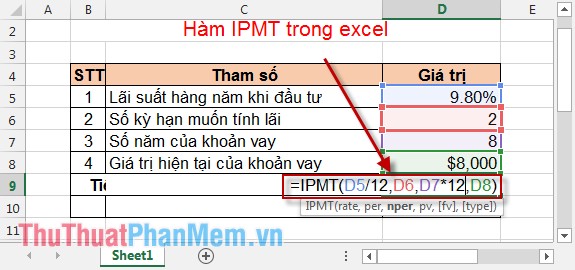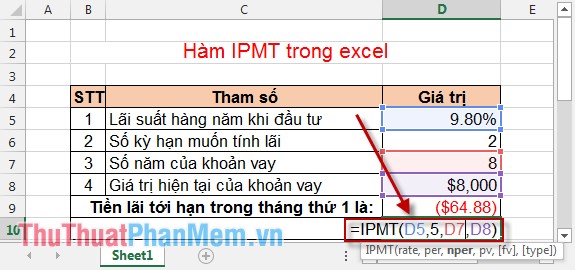Instructions for using the IPMT function in Excel
Before you decide to invest in a certain field, make sure you consider it very carefully, calculating what the capital is spent and how much is earned over the period of time with how much interest. . The following article is a guide to using IPMT function to help you answer this question.

Description: The function returns the interest payment for an investment within a certain agreed period.
Syntax: IPMT (rate, per, nper, pv, [fv], [type]) .
Inside:
- rate: The interest calculated periodically, is required parameters.
- per: The number of periods for interest calculation is from 1 -> nper, is a required parameter.
- nper: The total number of terms to be paid during the investment period, is the required parameter.
- pv: The present value of the loan, is the required parameter.
- fv: Future value obtained after investment, is an optional parameter if the default value is omitted to 0.
- type: Time of interest payment, Optional parameter if omitted by default is 0. There are 2 values of type = 0 => final payment, type = 1 => payment at the beginning of the period.
Example: Give the following data table:

Calculate:
- Interest is due in the 1st month after investing.
- Interest due in the last year of the loan.
Perform the problem:
1. Interest is due in the 1st month after investing
In the cell to calculate enter the formula: = IPMT (D5 / 12, D6, D7 * 12, D8) .

Result:

2. Interest is due in the last year of the loan
In the cell to calculate enter the formula: = IPMT (D5,5, D7, D8) .

Result:

The above is a detailed guide on how to pay interest when you decide to invest in a certain period of time. Compare it with the interest payments and the profits earned and then make a decision.
I wish you the best investment efficiency.
You should read it
- How to use the NPER function in Excel to plan loans and savings
- Basic Excel functions that anyone must know
- How to use Hlookup function on Excel
- How to use the SUM function to calculate totals in Excel
- Instructions on how to use the Dmax function in Excel
- How to use the LEN function in Excel
- How to use the RANDARRAY function to randomly classify data in Excel
- How to use COUNTIF function on Excel
May be interested
- How to use the RANDARRAY function to randomly classify data in Excel
 the randarray function in excel allows you to sort random data in excel. below are details on how to use the excel randarray function.
the randarray function in excel allows you to sort random data in excel. below are details on how to use the excel randarray function. - How to use COUNTIF function on Excel
 the countif function on excel is the cell count function to satisfy the given condition, often used in statistics tables.
the countif function on excel is the cell count function to satisfy the given condition, often used in statistics tables. - How to use the MOD function and QUOTIENT function in Excel
 injury in excel has many ways of doing it, can be used manually or using the calculation function.
injury in excel has many ways of doing it, can be used manually or using the calculation function. - 8 little-known Excel functions that can save you a lot of work
 even seasoned excel users often find themselves stuck performing tasks manually that could be automated with a few clever functions.
even seasoned excel users often find themselves stuck performing tasks manually that could be automated with a few clever functions. - How to use MID functions to get strings in Excel
 mid function in excel is a function that takes the middle character string corresponding to the value that the user requires to perform.
mid function in excel is a function that takes the middle character string corresponding to the value that the user requires to perform. - How to use Excel's VALUE function
 excel's value function will convert a string to a digital form, which can be combined with other functions such as left function, right function, mid function.
excel's value function will convert a string to a digital form, which can be combined with other functions such as left function, right function, mid function. - Instructions for using the TRIMRANGE function to clean up Excel tables
 trimrange is a brand new excel function that is being rolled out to users. this new function has the ability to remove blank rows from a range of data.
trimrange is a brand new excel function that is being rolled out to users. this new function has the ability to remove blank rows from a range of data. - How to use the function to delete spaces in Excel
 deleting white space with functions in excel makes it easier for users to handle content, instead of traditional editing.
deleting white space with functions in excel makes it easier for users to handle content, instead of traditional editing. - How to fix the SUM function doesn't add up in Excel
 in the process of summing with sum in excel, you will encounter some errors such as not jumping the number, not adding the sum. so how to handle this problem?
in the process of summing with sum in excel, you will encounter some errors such as not jumping the number, not adding the sum. so how to handle this problem? - Instructions on how to count words in cells in Excel
 in many cases you want to count the number of characters in a text string (text string) to calculate or combine with other functions, or to do something. you can then use the trim function, combining the len function, the substitute function. using the trim function to remove spaces, use the substitute function to replace the current text with new text in a text string, ...
in many cases you want to count the number of characters in a text string (text string) to calculate or combine with other functions, or to do something. you can then use the trim function, combining the len function, the substitute function. using the trim function to remove spaces, use the substitute function to replace the current text with new text in a text string, ...










 How to copy formulas that contain references in Excel
How to copy formulas that contain references in Excel Instructions for removing password PDF file online
Instructions for removing password PDF file online Instructions for hiding formulas in Excel
Instructions for hiding formulas in Excel Summary of technical functions in Excel
Summary of technical functions in Excel Create a border around Word documents
Create a border around Word documents Set the default file type when saving Word documents
Set the default file type when saving Word documents